Ceramsite blocks: characteristics and rules of laying
The construction of lightweight aggregate blocks is gaining more and more popularity in our country, because the use of structural thermal insulation materials saves resources spent on heating homes. In this article we will look at claydite-concrete blocks: the minuses and advantages of the material, its main characteristics and the rules for building walls of blocks.
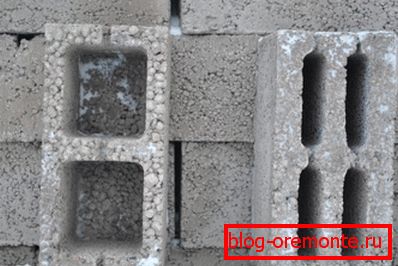
Expanded clay blocks
Composition

For the production of blocks using a kind of lightweight concrete, a large aggregate in which there is expanded clay. Expanded clay is a material obtained by heat treatment of foamed clay rolled into small balls. Due to the multitude of internal voids, claydite conducts heat poorly, which makes it considered a full-fledged heat insulator.
However, unlike other types of similar heat-insulating materials, such as foam plastic, polystyrene foam or polyethylene foam, expanded clay has a sufficiently high strength and heat resistance. Accordingly, the blocks also have a higher compressive strength and ability to withstand high temperatures.
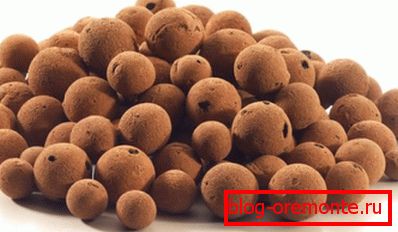
Produce material by making concrete with filling it with claydite instead of gravel. Then this solution is placed in a mold and subjected to volumetric vibropressing on special equipment. Modern vibropresses and machine tools make it possible to produce high quality concrete blocks and density, the strength of which makes it possible to build load-bearing walls in low-rise buildings.
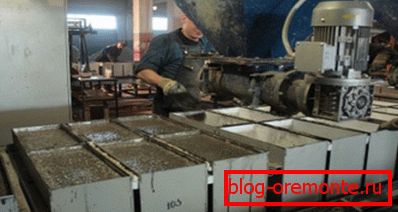
As a rule, for the production of blocks using Portland brand M400, sand and expanded clay with a grain size of 5 mm or more. These materials are mixed in a ratio of 1: 2: 3 (cement / sand / aggregate) or in other proportions calculated by a specific manufacturer according to one or another method.
Also included in the composition of various additives that increase the strength, ductility or moisture resistance of concrete. Large factory production facilities have their own laboratories and test equipment, with the help of which they determine the optimal composition and price / quality ratio.
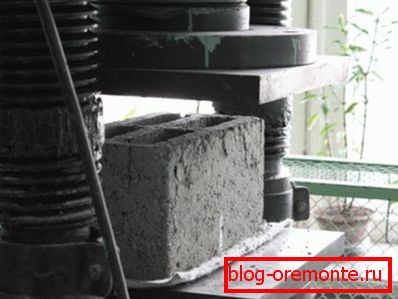
Note! Expanded clay is a much less durable material than granite or gravel; therefore, expanded clay concrete is significantly inferior to classic concrete in strength. This determines the main disadvantages of expanded clay concrete blocks.
Specifications
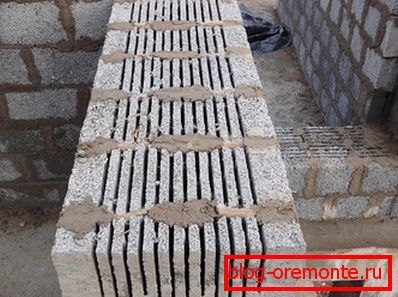
In order to fully characterize the wall building concrete block of expanded clay concrete, it is necessary to consider several important parameters: strength, density, ability to absorb moisture, thermal conductivity and resistance to low temperatures.
All these characteristics are standardized and are given in regulatory documents - GOST 6133-99 "Wall concrete stones. Technical conditions. We have identified the main indicators and tabulated them for your convenience:
| Characteristic | Units | Value |
| Density | kg / m3 | 700 - 1500 |
| Strength | kgf / cm2 | 50 - 150 |
| Frost resistance | Freeze-thaw cycle | 50 |
| Thermal conductivity | W / mGrad | 0.15 – 0.45 |
| Moisture absorption | % | < 50 |
| The time of complete cooling of the masonry | time | 75 - 90 |
| Shrinkage | mm / m | 0 |

As you can see, the material has a sufficiently high compressive strength, while its thermal conductivity allows to attribute keramsit concrete to heat insulators, since it is several times lower than that of a brick. In this case, the unit has a sufficiently high frost resistance, and if we consider that the material will hardly freeze through, then in this respect its durability is simply unlimited.
Размеры стандартного блока – 190х188х390 мм, для удобства расчетов их timeто округляют до 200х200х400. Перегородочные разновидности могут иметь другие размеры, чаще всего это 90х188х390 мм.
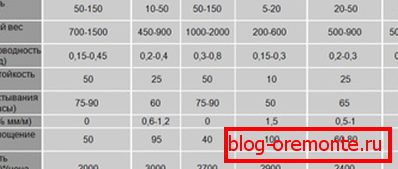
The brand of lightweight aggregate blocks is designated in the standard way: after the letters M indicate the maximum compressive strength that the product is able to withstand. For the construction of the walls of residential buildings and civil structures use products of the brands M50, M75 and M100.
Note! It is preferable to build bearing structures of M100 brand blocks.
Advantages and disadvantages
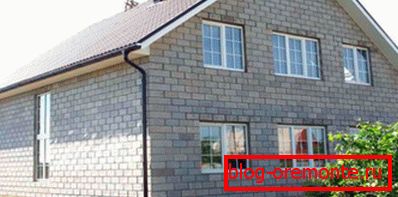
In order for our review to be objective, it is necessary to consider the advantages and disadvantages of expanded clay concrete blocks.
Let's start with the benefits:
- Low thermal conductivity and high energy efficiency of structures;
- The mass of the block is from 15 to 24 kg. For comparison, the mass of a similar volume of brick will be 21 - 30 kg, and taking into account the solution to 35 kg. This means that the load on the foundation will be lower, therefore, the cost of the base will also decrease;
- The volume of one standard product is 16,000 cm3, the volume of a single ceramic brick is 2000 cm3, that is, one unit replaces 6-7 bricks (including seams). This significantly speeds up the laying, facilitates the work and reduces the consumption of masonry mortar;
- If we look at how much the claydite-concrete block costs, we will see values between 45 and 60 rubles. The cost of 7 bricks will be at least 70 - 100 rubles;
- High heat resistance allows the use of the material even for the chimney, sudden changes in temperature, he is also not afraid;
- The material has good sound-absorbing qualities;
- Ease of processing for the manufacture of additional elements.
Note! Using this type of wall stone, you save not only at the stage of purchasing materials and construction work, but also during the operation of the building by reducing the cost of winter heating and summer air conditioning.

Now consider the disadvantages:
- Strength материала хоть и достаточна для возведения несущих стен, однако перед тем, как выбрать данную разновидность блоков, необходимо производить подробный расчет нагрузок и пределов прочности конструкций;
- The ability to absorb moisture is a characteristic feature of expanded clay. Therefore, it is desirable to cover the facade of the building with a ventilated structure or other type of finish that prevents wetting;
- Masonry requires the use of reinforcing inclusions and jute tapes to increase the strength of the walls and get rid of the cold bridges;
- The surface of the block is far from an aesthetic ideal and requires lining.
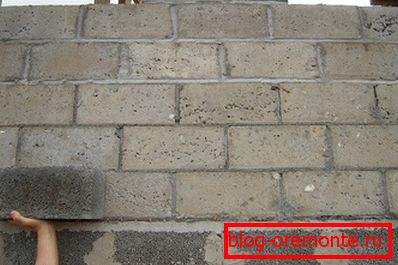
Note! Many of the shortcomings previously incriminated to this material are currently eliminated by improving the quality of production and equipment capabilities.
Wall construction

If you decide to build a house with your own hands - our instruction will help you:
- Before laying the lightweight aggregate blocks, the surface of the base or grillage should be leveled horizontally.. The zone of contact with the walls is insulated with a double layer of euroruberoid or bitumen mastic;
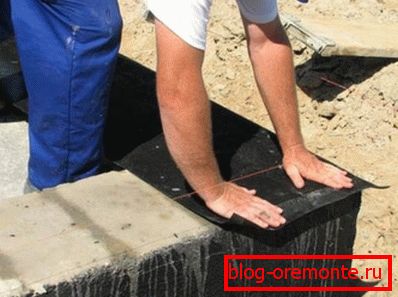
- In the corners, ordinal rails are set strictly vertically at a distance of 5–10 mm from the corner, at which the zero level and divisions for each row are marked (block height + seam thickness 10 mm), the rails are connected with a twine to guide. From the corner lay out the first row, which is aligned on the level;

- The upper face of the blocks of the first row is reinforced with two rods of steel reinforcement with a diameter of 8 mm (in grooves) or reinforcing mesh (without grooves), as well as jute tape. Then put a cement mortar (1: 4) with a layer of 20 mm on several stones at once, put the corner block and press it in. The next block is pressed at a distance of 5 cm from the angular one and pushed toward it, sealing the connection with a mallet;
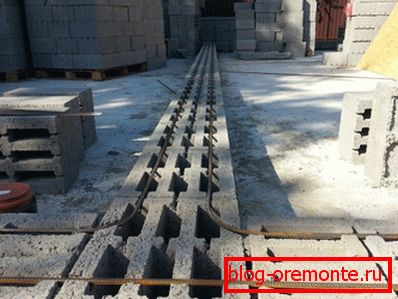
- The second row is laid out on the twine and is controlled by the level, then the twine is moved to the next division and the new string is continued. Jute tape is placed in each row, reinforcement - through 3 rows;
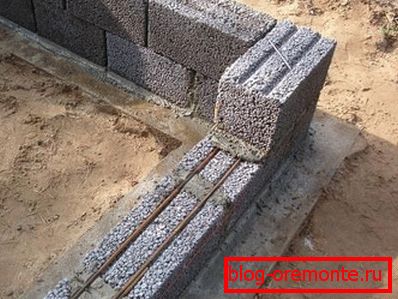
- Simultaneously with the bearing walls, partitions are built from solid or partition walls.. For better sound insulation, the joint between the wall and the partition can also be laid with jute;
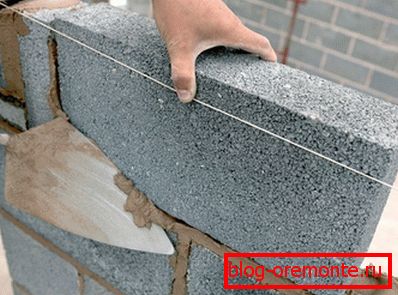
- When the walls are removed completely, they make a reinforced concrete belt.. This belt is then laid slabs or mauerlat.

Note! It is better to install concrete beams or metal channels above the openings, this will strengthen the construction.
Conclusion
The use of lightweight concrete with expanded clay significantly increases the energy efficiency of the building and accelerates the work. The video in this article will help you better understand how to put claydite-concrete blocks correctly.